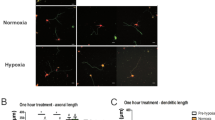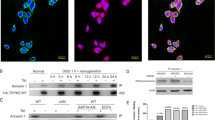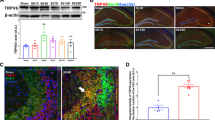Abstract
Transient receptor potential melastatin 7 (TRPM7) is a calcium-permeable divalent cation channel and mediates neuronal cell death under ischemic stresses. In this study, we investigated the contribution of TRPM7 to neuronal development in mouse primary hippocampal neurons. We demonstrated that TRPM7 channels are highly expressed in the tips of the growth cone. Either knockdown of TRPM7 with target-specific shRNA or blocking channel conductance by a specific blocker waixenicin A enhanced axonal outgrowth in culture. Blocking TRPM7 activity by waixenicin A reduced calcium influx and accelerated the polarization of the hippocampal neurons as characterized by the development of distinct axons and dendrites. Furthermore, TRPM7 coprecipitated and colocalized with F-actin and α-actinin-1 at the growth cone. We conclude that calcium influx through TRPM7 inhibits axonal outgrowth and maturation by regulating the F-actin and α-actinin-1 protein complex. Inhibition of TRPM7 channel promotes axonal outgrowth, suggesting its therapeutic potential in neurodegenerative disorders.







Similar content being viewed by others
Abbreviations
- TRPM7 channel:
-
Transient receptor potential melastatin 7 channel
References
Clapham DE, Julius D, Montell C, Schultz G (2005) International union of pharmacology. XLIX. Nomenclature and structure-function relationships of transient receptor potential channels. Pharmacol Rev 57:427–450
Fleig A, Chubanov V (2014) Trpm7. Handb Exp Pharmacol 222:521–546
Aarts M, Iihara K, Wei WL, Xiong ZG, Arundine M, Cerwinski W, MacDonald JF, Tymianski M (2003) A key role for TRPM7 channels in anoxic neuronal death. Cell 115:863–877
Sun HS, Jackson MF, Martin LJ, Jansen K, Teves L, Cui H, Kiyonaka S, Mori Y, Jones M, Forder JP, Golde TE, Orser BA, MacDonald JF, Tymianski M (2009) Suppression of hippocampal TRPM7 protein prevents delayed neuronal death in brain ischemia. Nat Neurosci 12:1300–1307
Monteilh-Zoller MK, Hermosura MC, Nadler MJ, Scharenberg AM, Penner R, Fleig A (2003) TRPM7 provides an ion channel mechanism for cellular entry of trace metal ions. J Gen Physiol 121:49–60
Ryazanova LV, Rondon LJ, Zierler S, Hu Z, Galli J, Yamaguchi TP, Mazur A, Fleig A, Ryazanov AG (2010) TRPM7 is essential for Mg(2+) homeostasis in mammals. Nat Commun 1:109
Inoue K, Branigan D, Xiong ZG (2010) Zinc-induced neurotoxicity mediated by transient receptor potential melastatin 7 channels. J Biol Chem 285:7430–7439
Hanano T, Hara Y, Shi J, Morita H, Umebayashi C, Mori E, Sumimoto H, Ito Y, Mori Y, Inoue R (2004) Involvement of TRPM7 in cell growth as a spontaneously activated Ca2+ entry pathway in human retinoblastoma cells. J Pharmacol Sci 95:403–419
Brauchi S, Krapivinsky G, Krapivinsky L, Clapham DE (2008) TRPM7 facilitates cholinergic vesicle fusion with the plasma membrane. Proc Natl Acad Sci U S A 105:8304–8308
Krapivinsky G, Mochida S, Krapivinsky L, Cibulsky SM, Clapham DE (2006) The TRPM7 ion channel functions in cholinergic synaptic vesicles and affects transmitter release. Neuron 52:485–496
Clark K, Langeslag M, Van LB, Ran L, Ryazanov AG, Figdor CG, Moolenaar WH, Jalink K, van Leeuwen FN (2006) TRPM7, a novel regulator of actomyosin contractility and cell adhesion. EMBO J 25:290–301
Nadler MJ, Hermosura MC, Inabe K, Perraud AL, Zhu Q, Stokes AJ, Kurosaki T, Kinet JP, Penner R, Scharenberg AM, Fleig A (2001) LTRPC7 is a Mg.ATP-regulated divalent cation channel required for cell viability. Nature 411:590–595
Jin J, Desai BN, Navarro B, Donovan A, Andrews NC, Clapham DE (2008) Deletion of Trpm7 disrupts embryonic development and thymopoiesis without altering Mg2+ homeostasis. Science 322:756–760
Dotti CG, Sullivan CA, Banker GA (1988) The establishment of polarity by hippocampal neurons in culture. J Neurosci 8:1454–1468
Gomez TM, Spitzer NC (2000) Regulation of growth cone behavior by calcium: new dynamics to earlier perspectives. J Neurobiol 44:174–183
Lohmann C, Finski A, Bonhoeffer T (2005) Local calcium transients regulate the spontaneous motility of dendritic filopodia. Nat Neurosci 8:305–312
Montell C (2005) The latest waves in calcium signaling. Cell 122:157–163
Mattson MP, Kater SB (1987) Calcium regulation of neurite elongation and growth cone motility. J Neurosci 7:4034–4043
Henley J, Poo MM (2004) Guiding neuronal growth cones using Ca2+ signals. Trends Cell Biol 14:320–330
Forscher P, Smith SJ (1988) Actions of cytochalasins on the organization of actin filaments and microtubules in a neuronal growth cone. J Cell Biol 107:1505–1516
Burridge K, Feramisco JR (1981) Non-muscle alpha actinins are calcium-sensitive actin-binding proteins. Nature 294:565–567
Fu X, Brown KJ, Yap CC, Winckler B, Jaiswal JK, Liu JS (2013) Doublecortin (Dcx) family proteins regulate filamentous actin structure in developing neurons. J Neurosci 33:709–721
Zierler S, Yao G, Zhang Z, Kuo WC, Porzgen P, Penner R, Horgen FD, Fleig A (2011) Waixenicin A inhibits cell proliferation through magnesium-dependent block of transient receptor potential melastatin 7 (TRPM7) channels. J Biol Chem 286:39328–39335
Gardzinski P, Lee DW, Fei GH, Hui K, Huang GJ, Sun HS, Feng ZP (2007) The role of synaptotagmin I C2A calcium-binding domain in synaptic vesicle clustering during synapse formation. J Physiol 581:75–90
Wei WL, Sun HS, Olah ME, Sun X, Czerwinska E, Czerwinski W, Mori Y, Orser BA, Xiong ZG, Jackson MF, Tymianski M, MacDonald JF (2007) TRPM7 channels in hippocampal neurons detect levels of extracellular divalent cations. Proc Natl Acad Sci U S A 104:16323–16328
Nejatbakhsh N, Guo CH, Lu TZ, Pei L, Smit AB, Sun HS, van Kesteren RE, Feng ZP (2011) Caltubin, a novel molluscan tubulin-interacting protein, promotes axonal growth and attenuates axonal degeneration of rodent neurons. J Neurosci 31:15231–15244
Schmitz SK, Hjorth JJ, Joemai RM, Wijntjes R, Eijgenraam S, De BP, Georgiou C, de Jong AP, Van OA, Verhage M, Cornelisse LN, Toonen RF, Veldkamp WJ (2011) Automated analysis of neuronal morphology, synapse number and synaptic recruitment. J Neurosci Methods 195:185–193
Silverman-Gavrila LB, Lu TZ, Prashad RC, Nejatbakhsh N, Charlton MP, Feng ZP (2009) Neural phosphoproteomics of a chronic hypoxia model–Lymnaea stagnalis. Neuroscience 161:621–634
Bentley D, Toroian-Raymond A (1986) Disoriented pathfinding by pioneer neurone growth cones deprived of filopodia by cytochalasin treatment. Nature 323:712–715
Middelbeek J, Kuipers AJ, Henneman L, Visser D, Eidhof I, Van HR, Wieringa B, Canisius SV, Zwart W, Wessels LF, Sweep FC, Bult P, Span PN, van Leeuwen FN, Jalink K (2012) TRPM7 is required for breast tumor cell metastasis. Cancer Res 72:4250–4261
Lowery LA, Van VD (2009) The trip of the tip: understanding the growth cone machinery. Nat Rev Mol Cell Biol 10:332–343
Zikopoulos B, Barbas H (2010) Changes in prefrontal axons may disrupt the network in autism. J Neurosci 30:14595–14609
Mingorance-Le MA, O’Connor TP (2009) Neurite consolidation is an active process requiring constant repression of protrusive activity. EMBO J 28:248–260
Schmitz C, Perraud AL, Johnson CO, Inabe K, Smith MK, Penner R, Kurosaki T, Fleig A, Scharenberg AM (2003) Regulation of vertebrate cellular Mg2+ homeostasis by TRPM7. Cell 114:191–200
Li M, Jiang J, Yue L (2006) Functional characterization of homo- and heteromeric channel kinases TRPM6 and TRPM7. J Gen Physiol 127:525–537
Chen HC, Xie J, Zhang Z, Su LT, Yue L, Runnels LW (2010) Blockade of TRPM7 channel activity and cell death by inhibitors of 5-lipoxygenase. PLoS One 5:e11161
Parnas M, Peters M, Dadon D, Lev S, Vertkin I, Slutsky I, Minke B (2009) Carvacrol is a novel inhibitor of Drosophila TRPL and mammalian TRPM7 channels. Cell Calcium 45:300–309
Qin X, Yue Z, Sun B, Yang W, Xie J, Ni E, Feng Y, Mahmood R, Zhang Y, Yue L (2013) Sphingosine and FTY720 are potent inhibitors of the transient receptor potential melastatin 7 (TRPM7) channels. Br J Pharmacol 168:1294–1312
Grimm C, Kraft R, Schultz G, Harteneck C (2005) Activation of the melastatin-related cation channel TRPM3 by D-erythro-sphingosine [corrected]. Mol Pharmacol 67:798–805
Ozaki T, Mohammad S, Morioka E, Takiguchi S, Ikeda M (2013) Infant satiety depends on transient expression of cholecystokinin-1 receptors on ependymal cells lining the third ventricle in mice. J Physiol 591:1295–1312
Schmitz C, Dorovkov MV, Zhao X, Davenport BJ, Ryazanov AG, Perraud AL (2005) The channel kinases TRPM6 and TRPM7 are functionally nonredundant. J Biol Chem 280:37763–37771
Zhang Z, Yu H, Huang J, Faouzi M, Schmitz C, Penner R, Fleig A (2014) The TRPM6 kinase domain determines the Mg.ATP sensitivity of TRPM7/M6 heteromeric ion channels. J Biol Chem 289:5217–5227
Prescott AR, Comerford JG, Magrath R, Lamb NJ, Warn RM (1988) Effects of elevated intracellular magnesium on cytoskeletal integrity. J Cell Sci 89(Pt 3):321–329
Krapivinsky G, Krapivinsky L, Manasian Y, Clapham DE (2014) The TRPM7 chanzyme is cleaved to release a chromatin-modifying kinase. Cell 157:1061–1072
Perraud AL, Zhao X, Ryazanov AG, Schmitz C (2011) The channel-kinase TRPM7 regulates phosphorylation of the translational factor eEF2 via eEF2-k. Cell Signal 23:586–593
Scheetz AJ, Nairn AC, Constantine-Paton M (2000) NMDA receptor-mediated control of protein synthesis at developing synapses. Nat Neurosci 3:211–216
Gomez TM, Letourneau PC (2014) Actin dynamics in growth cone motility and navigation. J Neurochem 129:221–234
Wei C, Wang X, Chen M, Ouyang K, Song LS, Cheng H (2009) Calcium flickers steer cell migration. Nature 457:901–905
Sigurdson WJ, Morris CE (1989) Stretch-activated ion channels in growth cones of snail neurons. J Neurosci 9:2801–2808
Jacques-Fricke BT, Seow Y, Gottlieb PA, Sachs F, Gomez TM (2006) Ca2+ influx through mechanosensitive channels inhibits neurite outgrowth in opposition to other influx pathways and release from intracellular stores. J Neurosci 26:5656–5664
Acknowledgments
This work was supported by the following grants: NIH NIGMS P01 (GM078195) to AF, Natural Sciences and Engineering Research Council of Canada (NSERC) Discovery Grants to ZPF (RGPIN 249962) and to HSS (RGPIN 402733), a Canada Foundation for Innovation (CFI #29066) Leader of Opportunity Fund and Ontario Research Fund (ORF) to HSS, a Canadian Institute of Health Research (CIHR) Frederick Banting and Charles Best Canada Graduate Scholarship to ET, Ontario Graduate Scholarships to CB (OGS-MSc) and to AB (OGS-PhD), and a New Investigator Award from the Heart and Stroke Foundation of Canada (HSFC) to ZPF.
Author information
Authors and Affiliations
Corresponding authors
Electronic supplementary material
Below is the link to the electronic supplementary material.
Supplementary Figure 1
Confirmation of AAV-1 vector efficiency. A) AAV-1 vectors infected neurons with near 100% efficiency, determined by EGFP expression. Comparing between the number of neurons in top image (indicated by red dots, n = 27) and EGFP fluorescent neurons (n = 26) in the bottom image, 96.3% of the neurons were infected. B) Western blot showing a single protein band for hippocampal (HPC) and prefrontal cortex (PFC) regions of mouse and rat brain tissues labeled by the TRPM7 antibody used in C. C) Representative confocal immunofluorescence images obtained from E17.5 mouse hippocampal neurons on DIV6 treated with AAV-1 viruses containing eGFP only (n = 28), scrambled shRNA (n = 26), or TRPM7 shRNA (n = 43). eGFP (green), NeuN (red), and TRPM7 (blue) are shown. D) Summary of the relative expression levels of TRPM7 against NeuN. The graph is expressed as mean ± SEM (*** p <0.001). (GIF 213 kb)
Supplementary Figure 2
Neurite analysis of TRPM7 knockdown neurons. A) A schematic representation of primary, secondary and tertiary neurites. B) Number of primary, secondary and tertiary of DIV4, C) DIV6 and D) DIV8 neurons in three different treatment groups. For groups at DIV4: eGFP only n = 42, scrambled shRNA n = 43, TRPM7 shRNA n = 48; for groups at DIV6: eGFP only n = 26, scrambled shRNA n = 40, TRPM7 shRNA n = 35; for groups at DIV8: eGFP only n = 25, scrambled shRNA n = 20, TRPM7 shRNA n = 23. Data is shown as mean ± SEM. Statistical analysis: One-way ANOVA with Bonferroni post-hoc. (GIF 74 kb)
Supplementary Figure 3
Quantitative analysis of neuronal transition between second and third developmental stages. A) Formula for calculating the difference between the length of longest neurite and the average length of the remaining neurites. B) Average length difference of DIV2 and DIV3 neurons in different treatment groups. C) Average length difference of stage 2 and stage 3 neurons in different treatment groups at DIV2 and DIV3. Data is presented as mean ± SEM. Statistical analysis: one-way ANOVA with Bonferroni post-hoc (*p < 0.05; ***p < 0.001). D) Distribution of neurons in stage 2 and stage 3 in different treatment groups at DIV2 and DIV3, based on the assumption that the length difference for stage 3 is ≥ 0.67. Chi-square: DIV2 untreated control vs. waixenicin A P = 0.0015; DIV3 untreated control vs. waixenicin A P = 0.0046. For groups at DIV2: untreated control n = 73; vehicle control n = 68; waixenicin A n = 69. For groups at DIV3: untreated control n = 63; vehicle control n = 62; waixenicin A n = 62. (GIF 119 kb)
Supplementary Table 1
Summary of Pearson correlation coefficient values for the colocalization analysis. Summary of Rrs in different neuronal structures and the % change in Rr in the between the control and waixenicin A-treated neurons. (GIF 66 kb)
Rights and permissions
About this article
Cite this article
Turlova, E., Bae, C.Y.J., Deurloo, M. et al. TRPM7 Regulates Axonal Outgrowth and Maturation of Primary Hippocampal Neurons. Mol Neurobiol 53, 595–610 (2016). https://doi.org/10.1007/s12035-014-9032-y
Received:
Accepted:
Published:
Issue Date:
DOI: https://doi.org/10.1007/s12035-014-9032-y




